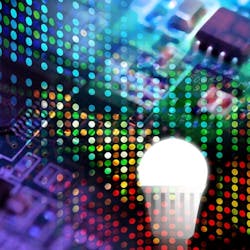RayVio hits 45 mW in a laboratory demonstration of a deep-UV LED
Startup RayVio progresses in its effort to deliver UV LED devices with output power and lifetime characteristics that will enable applications such as sterilization.
RayVio has announced the results of a laboratory demonstration of an ultraviolet (UV) LED that produces 45 mW of continuous output power in what the company called deep-UV wavelengths. The performance level in the demonstration is more than four times higher than the highest-performance UV LED currently being sold by RayVio and such improvements in performance will be vital in RayVio enabling new solid-state lighting (SSL) products for applications such as sterilization.
RayVio is focused on applications in the UV-B (280–315 nm) and UV-C (100–280 nm) spectra. Efficiency and reliability have been a challenge for LED manufacturers working at such wavelengths. But a UV LED such as this could enable a host of important applications including portable or even solar-powered water purification systems. The technology could also be used to disinfect surfaces. In a Strategies in Light (SIL) presentation made in 2014, Yitao Liao, RayVio co-founder and CTO, said that smartphones might include a UV-C LED in the future, enabling a person to disinfect a table at a restaurant.
The latest RayVio demonstration was based on an LED chip with a 0.15-mm2 emitting surface. The performance translates to a continuous-wave (CW) power density of 30 W/cm2, which RayVio said was a record-high achievement in the industry.
RayVio has not revealed details of its approach to manufacturing UV LEDs but has said that it is using standard sapphire substrates, and that the work should allow the company to boost performance and lifetime on a curve that mimics progress made in the past two decades in visible-light LEDs.
"Our novel UV LED technology continues to validate its superiority," said Liao. "This enables us to unleash Haitz’ Law for deep UV LEDs, the same Haitz’ Law that enabled blue and white LEDs to revolutionize the lighting and display industries."
RayVio began shipping its first UV LED products earlier this year. Currently, the company has products in the 270–290-, 290–310-, 310–330-, and 330–350-nm bands. The company said it is engaging with OEM customers working on applications including curing, dermatology, biomedical instrumentation, and disinfection/sterilization. Curing generally uses LEDs in the higher spectra, including UV-A (315–400 nm) LEDs that are more broadly available on the market as we covered in a feature article. But the shorter-wavelength LED technology could hold far more profit potential in the long term. "We’re extremely excited by the overwhelming level of customer interest received thus far from a wide variety of industries," said CEO Robert Walker.
The company would not say when it expects to deliver commercial UV LEDs at the power levels achieved in the lab. But based on the company's progress thus far, we'd expect the LEDs to hit the market within a year. Walker said the demonstration was based on an LED in a typical form factor for commercial products.
RayVio only emerged from stealth operations mode earlier this year when Walker made a presentation at the SIL Investor Forum. Later in March, RayVio announced it had raised $9.3 million in Series B venture funding from Applied Ventures, Augment Ventures, New Ground Ventures, Tolero Ventures, DCM Ventures, and Capricorn Investment Group.
The new funding is enabling the company to both create a market presence and to ramp manufacturing capabilities. Walker said, "Leading OEM and consumer electronics manufacturing partners have been evaluating our current products for the past several months, while we continue to install more capacity at our facility in Silicon Valley and ramp global supply chain partners to satisfy customer demand."

Maury Wright | Editor in Chief
Maury Wright is an electronics engineer turned technology journalist, who has focused specifically on the LED & Lighting industry for the past decade. Wright first wrote for LEDs Magazine as a contractor in 2010, and took over as Editor-in-Chief in 2012. He has broad experience in technology areas ranging from microprocessors to digital media to wireless networks that he gained over 30 years in the trade press. Wright has experience running global editorial operations, such as during his tenure as worldwide editorial director of EDN Magazine, and has been instrumental in launching publication websites going back to the earliest days of the Internet. Wright has won numerous industry awards, including multiple ASBPE national awards for B2B journalism excellence, and has received finalist recognition for LEDs Magazine in the FOLIO Eddie Awards. He received a BS in electrical engineering from Auburn University.





